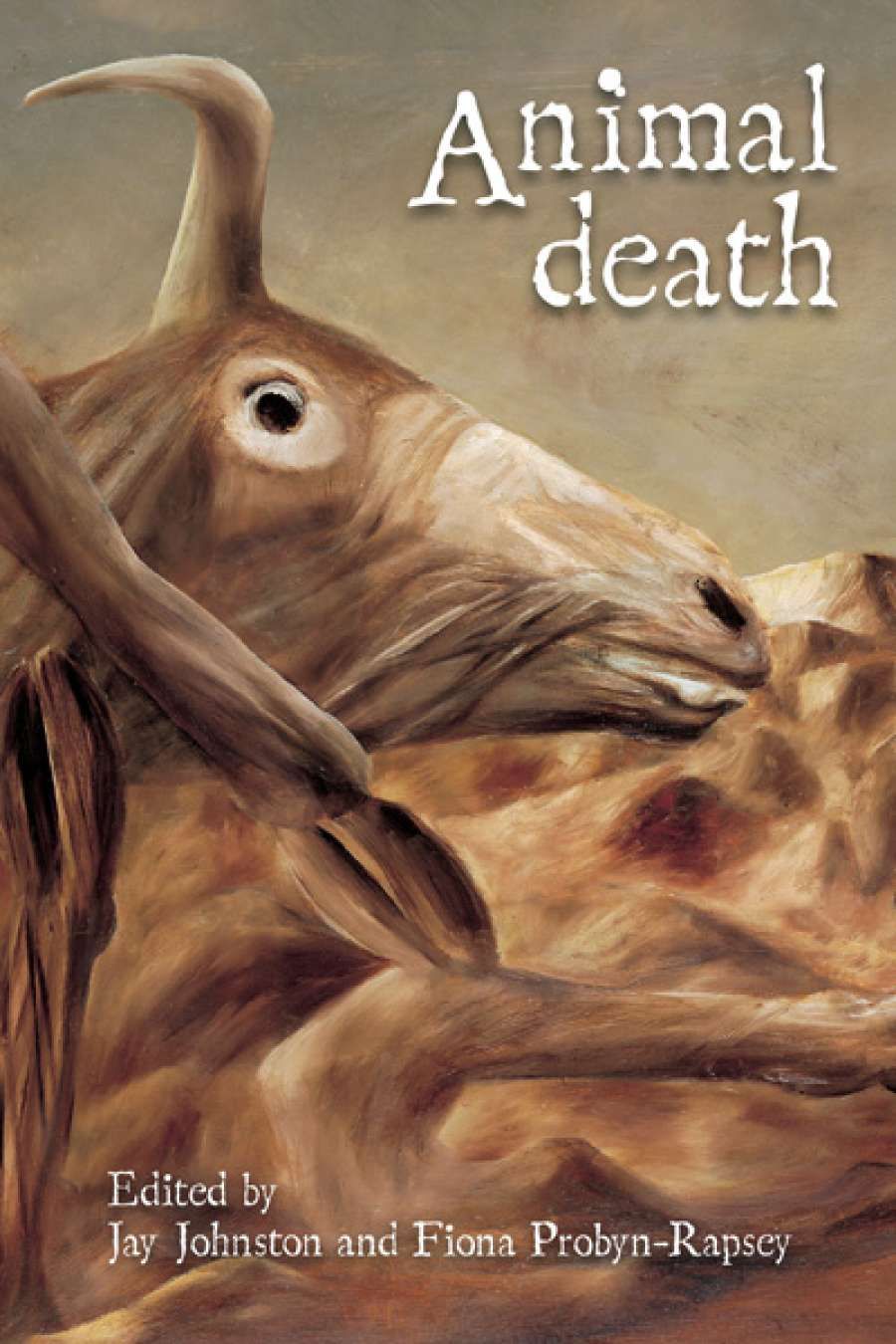
- Free Article: No
- Contents Category: Animal Rights
- Review Article: Yes
- Online Only: No
- Custom Highlight Text:
As Carol Freeman notes in a footnote to her chapter in Animal Death, ‘what the term “animal studies” defines is still being debated’. The seventeen chapters of this edited volume range across historical, scientific, cultural, and artistic animal-related subjects. They reflect a self-conscious commitment on the part of editors Jay Johnston and Fiona Probyn-Rapsey to the transdisciplinary nature of this inchoate field of scholarship. Although the title and unifying theme of Animal Death might seem to betoken a narrow focus on confrontational questions surrounding the killing of animals by humans – which are at times addressed unflinchingly – in actuality the book’s compass is far wider. It is a text that will be of great value to novices and experienced animal studies scholars alike: the kind of book a reader should be wary of opening with a pencil in hand, lest she find herself underlining the whole thing.
- Book 1 Title: Animal Death
- Book 1 Biblio: Sydney University Press, $30 pb, 345 pp
Animal Death developed from a symposium of the Human Animal Research Network at Sydney University in 2012. Its purpose was to bring together ‘cross-disciplinary voices’ and to explore ‘how animal and human death diverge and also connect in profound ways’. The volume includes a foreword by Michael Kirby (Patron of Voiceless, the animal protection institute), who writes: ‘Dear reader, be warned. Reading about animal death may prove a life-changing experience.’
The editors’ introductory statements, that animal death is ‘a tough subject to face’ and ‘[t]he sheer scale of animal death is mind-boggling’, bring to mind contexts such as factory farming, vivisection, species extinction, and ‘pest’ culls. The authors who address these issues do so neither morbidly nor superficially, but by identifying cultural conditions that enable these practices to proliferate. Annie Potts and Philip Armstrong, for example, demonstrate how chickens have sunk in the human imagination into dim-witted caricatures that are considered food even while alive, and investigate how visual culture may be used proactively to ameliorate their status. Probyn-Rapsey’s chapter juxtaposes the whiteness of ‘standardised’, ‘invisibilised’ broiler chicks and laboratory mice with albino animals (e.g. white gorillas and tigers), whose identities are synonymous with ‘spectacularisation’ and ‘hypervisibility’.
Elsewhere, the volume engages with animal death in ways that are less expected. A representative example is Matthew Chrulew’s account of the modernising Swiss zoo director Heini Hediger. Chrulew explains how Hediger’s commitment to eliminating ‘deaths due to behaviour’ (those attributable to avoidable factors) led to his developing innovative ways of comprehending animal existence that were applied both to extend the longevity of zoo animals and to eliminate vermin. Other chapters look at pet cemeteries, ‘euthanasia’ as applied to animals (and the emotional cost to veterinarians), and the growth among contemporary online forums of ‘Otherkin’: a heterogeneous subculture comprising individuals who believe themselves to be other than entirely human.
The chapters of Animal Death dealing with artistic expression underline the editors’ desire to identify effective responses to cultural mechanisms which ‘[cultivate] indifference and silence’ towards animal mortality. Peta Tait contrasts an exhibition of ‘plastinated’ animal bodies (where body fluids are replaced with silicon, acetone, and resin) with the use of replica animals in contemporary theatre. Melissa Boyde and Carol Freeman respectively examine depictions of animal death in novel and film: the former in adaptations of Wake in Fright (1961/1971) and Red Dog (2001/2011); the latter in Julia Leigh’s The Hunter (1999/2011). The report that Tarsh Bates and Megan Schlipalius give of their durational performance in vitero, which displayed insects, fungi, and yeasts in a public gallery, offers intriguing insight into human responses to deaths of ‘lower order nonhumans’: ‘we do not lament the death of a fly in our fruit bowl, mould in our bathroom, or the treatment of a candida infection.’ Deborah Bird Rose’s chapter, ‘In the Shadow of All This Death’, eloquently interweaves fictional and non-fiction illustrations to argue for ‘an ethical poetics that brings us into proximities that awaken us both to others and to ourselves’.
The editors explain that Animal Death is intended to respond to Stanley Cohen’s concept that people often do not ‘care to know’ about the killing of animals. A danger for animal studies is that too heavy an emphasis on animal suffering and death risks catalysing further inertia: either by contributing to a sense of powerlessness, or by provoking others to rile against perceived opprobrium. From this perspective, Animal Death is a triumph. The chapters dealing with issues such as factory farming are unsparing, but equally argue that optimism is not impossible if such topics are broached with cultural and philosophical understanding. The inspiring and inclusive ways in which the book challenges readers are enhanced by the chapters dealing with animal death in less predictable settings, and by its artistically oriented interrogations.
Bird Rose’s chapter describes how all living things are entangled within the kinship of ‘those who are born to die’. She writes: ‘The expression of our ethical lives will be visible in how we inhabit the death zone: how we call out, how we refuse to abandon others, how we refuse hard-heartedness, and thus how we embrace the precious beauty that permeates the house of life.’
To the credit of Animal Death’s contributors and editors, no reader of the book need feel excluded from this at once descriptive and aspirational conception of life.


Comments powered by CComment